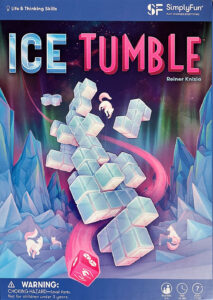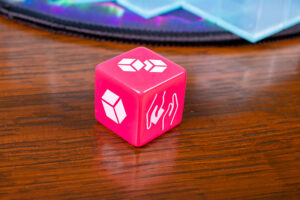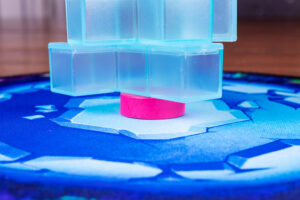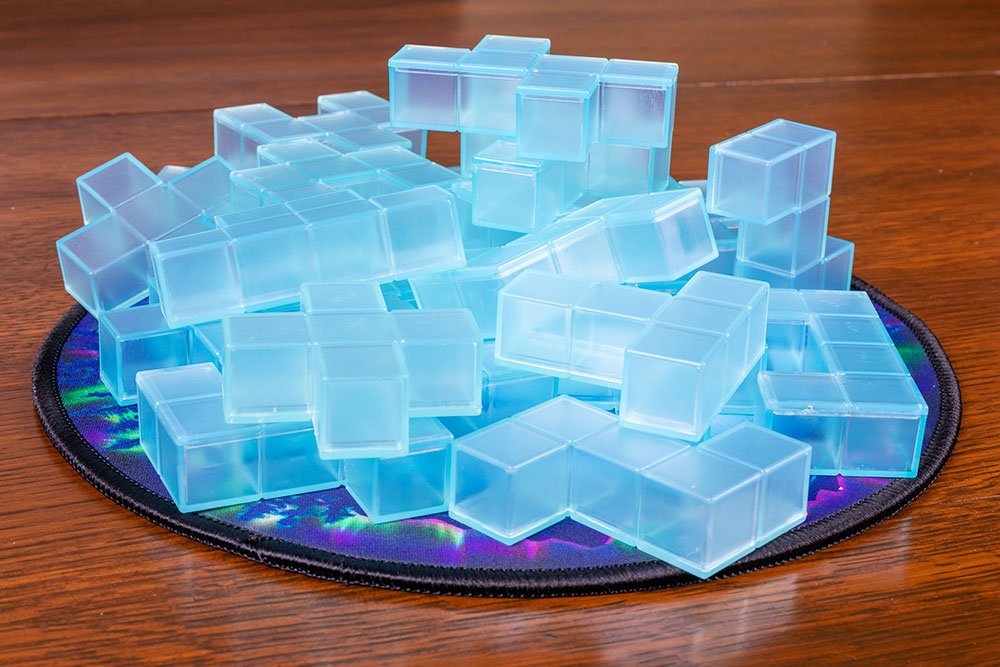 Dr. Reiner Knizia is probably one of the most well-known game designers in the tabletop space. Since the early 90s, he’s published over 600 board games! These include award-winning games such as Modern Art, The Quest for El Dorado, and High Society. Yet not every one of his titles is a brain-burning euro. Today, we are going to look into a family weight dexterity game of his called Ice Tumble. Published by Simply Fun, Ice Tumble accommodates 2-4 players and takes about 15 minutes to play.
Dr. Reiner Knizia is probably one of the most well-known game designers in the tabletop space. Since the early 90s, he’s published over 600 board games! These include award-winning games such as Modern Art, The Quest for El Dorado, and High Society. Yet not every one of his titles is a brain-burning euro. Today, we are going to look into a family weight dexterity game of his called Ice Tumble. Published by Simply Fun, Ice Tumble accommodates 2-4 players and takes about 15 minutes to play.
Gameplay Overview:
To start, a bunch of polyomino-shaped blocks are piled in the middle of the table. Players take turns rolling a 6-sided die and based on the results, take 1-2 blocks from the center, or 1 from an opponent. If any of the blocks move while claiming them from the pile, you must take a second block as a penalty. Once all the blocks are taken, players move on to phase 2.
In this phase, players will again roll the 6-sided die and resolve the result. This will be either stacking 1 or 2 blocks on the tower or giving a block to an opponent. If the tower ever tumbles, the fallen pieces are put back in the box and the player takes 2 of the blocks as a penalty. The game ends once a player has placed their last block and put their player pawn on top of the tower.
Game Experience:
Despite the pedigree of the designer, Ice Tumble is a fairly light game. The main thing that sets it apart from other stacking games of this genre is the claiming of blocks at the start and the rolling of the die. Yet, ironically, those are the two least impressive parts of the game.

While I was fine with the randomness of stacking either 1 or 2 blocks on a turn, we didn’t like the hand icon. Having to take blocks from an opponent in phase 1 can lead to kingmaker opportunities. In a 3 player game, I’ve seen 2 players constantly take blocks from the player they liked better than the other, leaving one player with significantly fewer blocks than everyone else. And in phase 2, it has you giving blocks to an opponent, which is fine, but feels wholly unnecessary. This bit of randomness doesn’t really help balance a run-away leader, and it just makes someone’s turn way easier. I would probably eventually just house rule the hand icon out of the game altogether.

Speaking of phase one, that was a neat idea. Claiming blocks from a pile and getting a penalty if any other ones shift. The problem is that there really isn’t much of a difference from one block to another. There really isn’t any reason you’d want to risk taking a more precarious block. 9 times out of 10 (maybe even 10 out of 10), you are just going to take whatever is the most accessible block. It would be different there were single squares, or 2×1 blocks. But with every block being 5 or 6 pieces, they all felt kind of the same. And since you don’t build the tower until phase two, so you have no idea what block will be easier to place on a given turn.
That all being said, building the tower was still fun and created a good amount of tense moments. Players have the option of using a smaller base platform if they want a riskier game. I also liked how the game wasn’t over if the tower fell off. Having to only take a 2 block penalty was a nice choice, as it still keeps the player invested. If they had to claim all of the blocks, then one tumble probably would have put the game out of reach for that player.

Final Thoughts:
Ice Tumble is a fine game, yet it also is going to struggle to set itself apart in a genre with some already great options. I didn’t like how the die was used, and phase 1 felt kind of unnecessary. However, phase 2 was a decent amount of fun, and the penalties for knocking the tower over weren’t overly punishing. If you are a stacking game addict, Ice Tower could be worth a look. For everyone else, I’d probably recommend one of the classics like Junk Art, Meeple Circus, or Rhino Hero.
Final Score: 2.5 Stars – Some neat ideas here, but other parts feel a little unnecessary.
 Hits:
Hits:
• Knocking over the tower isn’t overly punishing
• Different difficulty levels with the platforms
Misses:
• Not enough variety in the blocks to make phase 1 feel worthwhile
• Hand icon on the die feels unnecessary






















